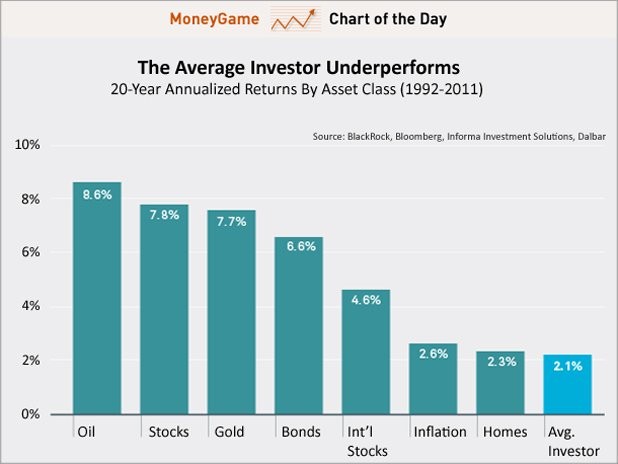The only 7 investments you need
Post on: 29 Сентябрь, 2015 No Comment

xyz
The Worst Way to Invest in Today's Market
With the market still down about 25% over the past year, there should be plenty of cheap stocks out there today. Right? NO! It depends.
Specialty ETFs: Are They Worth the Extra Freight?
Specialty ETFs aim to beat the market. They are strategy portfolios based on stocks screened for specific criteria. Here, Buy-Write, Insider buying, Convertible Bond, Preferred Share, Private equity, and Patent-focused ETFs are discussed.
A Close Look at Five Biotech ETFs
SPDR Biotech ETF (XBI), PowerShares Dynamic Biotech & Genome (PBE), IShares NASDAQ Biotechnology (IBB), First Trust AMEX Biotechnology (FBT), and finally the Biotech HOLDRs (BBH).
What to ask your next mortgage broker?
To survive the shakeout in their industry, mortgage brokers will have to do business more transparently. A number of bills before Congress would require them to disclose fees and take on a fiduciary responsibility — that is, represent their client's best interest.
Global Depository Receipt
Q: I am self-employed and fund a SEP-IRA each year. Can I open an individual Roth 401(k) as well?
Supply and Demand
The supply of stock is mushrooming — a bearish sign
The only 7 investments you need
1. A blue-chip U.S.-stock fund
First choice: Fidelity Spartan 500 Index (FSMKX)
Not so long ago, the idea that U.S. stocks should be at the core of any investment strategy would have been deemed too obvious to discuss. This decade, in which the brutal 2000-02 bear market and the current downturn have left the S&P 500 stuck where it started, may have changed that.
Let’s review: Since 1967 there have been seven bear markets, with losses ranging from 19% to 49%. Even so, the annual gain for blue-chip U.S. stocks is 10.8% — far outpacing bonds. Those painful but temporary losses are the price you pay for higher potential returns.
And those gains are the best defense against the corrosive effects of inflation. Are stocks better than gold at whipping inflation? Way better: Since 1908, stocks have grown more than eightfold after inflation; gold has little more than doubled in today’s dollars.
Although U.S. firms no longer dominate the world, their stocks still account for more than 40% of the world’s equity value. So U.S. blue chips need to be at the heart of a diversified strategy.
The best way to own them is through the Fidelity Spartan 500 Index fund. It replicates the performance of the S&P 500 and takes only a sliver of a fee for doing so: 0.10% a year. Alternatives: iShares S&P 500 Index (IV) and Selected American Shares (SLASX)
2. A blue-chip foreign-stock fund
First choice: Vanguard Total International Stock Index (VGTSX)
The most important reason you need to own foreign stocks has nothing to do with the fact that they’ve trounced U.S. equities for the past five years. Sticking only with domestic stocks is akin to shopping in a store that’s missing most of its inventory: Nearly 60% of the world’s stock market value resides in companies outside our borders.
Besides, since investing in stocks is all about owning a piece of a growing economic pie, you have to go to where the growth is — and 76% of the world’s economic activity takes place outside the U.S.

Then there’s the diversification argument. Even though foreign markets held up no better than U.S. ones in the current downturn, overseas diversification still works. Researchers at T. Rowe Price found that since 1970, a 20% weighting in foreign equities both raised a U.S. fund portfolio’s return and cut its risk.
The simplest way to add stocks from both developed and emerging economies to your portfolio is to own Vanguard Total International Stock Index. As an index fund, it merely aims to match the return of the world’s stock markets. Thanks to the inherent wisdom and efficiency of this approach — the fund charges a tiny 0.27% a year in expenses — it has outperformed more than 90% of its peers over the past five years. Alternatives: Vanguard FTSE All World Ex-U.S. ETF (VEU) and Dodge & Cox Intl. Stock (DODFX )
3. A small-company fund
First choice: T. Rowe Price New Horizons (PRNHX)
The greatest returns in the stock market come from taking above-average risks. That’s why over periods of a decade or longer, small-company funds — which own shares of small, dynamic companies — can outpace the rest of the market by an average of one to three percentage points a year.
This isn’t the only reason to carve out a permanent niche in your portfolio for such funds. They sometimes pick up steam just when blue chips stagnate, making them a great diversifier. In the 1970s, for instance, small stocks delivered nearly twice the gains of blue chips.
Adding that small-cap performance gives you a nice extra bit of diversification, says Frank Armstrong, founder of the advisory firm Investor Solutions. This category makes particular sense when you’re decades from needing to tap your portfolio. The farther off that goal, the more time you have to benefit from small-stock funds’ long-term growth, and the less you need to worry about their periodic nosedives.
Most of our first-choice picks are index funds, but this one is an exception: T. Rowe Price New Horizons. In this category, it may be worth paying slightly more — just slightly — for active management, and New Horizons is one of the most efficient of the actively managed crowd. Alternatives: Vanguard Small-Cap Index (NAESX) and Vanguard Small-Cap ETF (VB)
4. A value fund
First choice: Vanguard Value Index (VIVAX) The universe of equities is divided into two groups: growth stocks, which are shares of high-performing companies that often trade at steep prices (relative to their earnings growth or assets); and value investments, overlooked or beaten-down shares selling at discount prices. Why do you need to bother with the bargain-basement bin? For starters, value stocks typically pay out significantly higher dividends than growth companies. Today, in fact, the average value stock in the S&P 500 yields 3.5% — nearly twice what growth stocks pay out. Dividends give value stocks a steadier source of return than growth funds, which rely almost entirely on the market’s opinion. That’s one reason that over long stretches, value trumps growth more often than not. In the equity investors’ bible, Stocks for the Long Run, University of Pennsylvania professor Jeremy Siegel points out that value returned an average of 15.7% a year between 1975 and 2001, nearly two points a year more than growth stocks. When choosing a value fund, the last thing you want to do is overpay. Vanguard Value Index is a cost-effective way to buy the universe of blue-chip value stocks for just 0.20% in annual fees. The low costs explain how this plain-vanilla fund has returned about 13% a year since 2003, beating 78% of its peers. Alternatives: iShares S&P 500 Value Index (IVE) and T. Rowe Price Equity Income (PRFDX)
5. A high-quality bond fund














